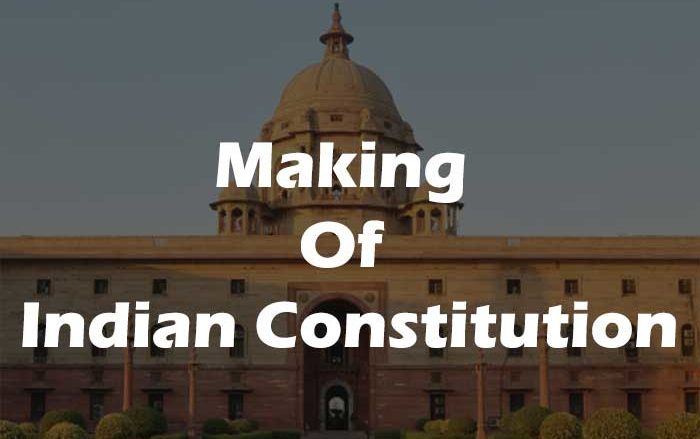Every Indian citizen should know the making of Indian Constitution at this time. Without the “Constitution” India would not be able to run the Center and state this much smooth. Constitution laid the default principles, which how an ordinary man, Central Government, State Government, Judiciary should act.
Indian Polity Notes – Video
If you are too bored to read the entire theory part, then go with this Indian Polity Notes – Video Below.
Indian Polity – Constitution
It was in 1934 that the idea to create a Consitution for India without any interference from other countries. (Especially from Britain) M.N. Roy first coined this Idea, and then in 1935 Indian National Congress (INC) officially demanded for the first time for the Constitution. Consequently, in 1938, Jawaharlal Nehru announced on behalf of INC, that Indian Constitution would be framed without any outside interference by the constituent assembly members elected by Adult Franchise.
The demand was accepted by the British in 1940 and also it is known as ‘August Offer’. Following that, in 1942 Sir Stafford Cripps came to India with a draft proposal by the British Government on the framing of Indian Constitution after the World War II. Later on, it was denied by the Muslim League which wanted to divide India into two autonomous parts.
Formation of Constituent Assembly
The Constituent Assembly was constituted in November 1946 under the scheme formulated by the Cabinet Mission Plan. According to the Scheme, the Constituent Assembly was to be 389. Out of these 296 seats to be allotted to British India and 93 seats to the Princely States. Out of, 296 seats to British India, 292 members were to be drawn from 11 Governor Province’s and four from 4 Chief Commissioner’s Province’s.
Seats allocated to the British Provinces and the Princely States are based on the Proportion to their respective Population. (1 seat for Million Population). And also seats should be decided among the three principal communities like Muslim, Sikhs and General Communities (Other than the First two communities). The representatives of each community should be elected by the members of that community by the method of Proportional representation through a single transferable vote.
But in the Princely States, the representatives were nominated by the head of the Princely States.
So it will be clear that the Constituent Assembly was a mixture of Partly elected and Partly nominated body.
Elections to the Constituent Assembly
The Elections to the Constituent Assembly held in July- August 1946. As an outcome, the Indian National Congress won 208 seats, and the Muslim League won 73 seats, and the remaining 15 seats won by some small independent groups. The Princely States decided to stay away from the Constituent Assembly as they failed to show their majority.
The elected Constituent Assembly comprised representatives of all sections of Indian Society like Hindu, Muslims, Sikhs, Parsis, Anglo- Indians, Indian Christians, SCs and STs including Women of all these sections. The Constituent Assembly include with all personalities except Mahatma Gandhi and MA Jinnah.
Working of Constituent Assembly
The Constituent Assembly held its first meeting on December 9, 1946. Only 211 members attended the Meeting. Muslim league entirely boycotted the meeting demanding a separate state of Pakistan. Dr. Sachchidanand Sinha, the Oldest member, was elected as the Interim (Temporary)President of the Assembly, following the French Practice.
Later, on December 11, 1946, Dr. Rajendra Prasad and HC Mukherjee were elected as the President and Vice- President of the Constituent Assembly respectively. B.N Rau was appointed as the Constitutional Advisor to the Assembly.
Historic Move By Jawaharlal Nehru
On December 13, 1946, Jawaharlal Nehru moved the historic ‘Objective Resolution’ in the Constituent Assembly. It laid down the fundamentals and Philosophy of the Constitutional Structure. It primarily speaks about India as the Independent Sovereign Republic, the transformation of the territories of British India into the Indian States, Judicial, Political and equal opportunities to the citizens were the key points.
The Resolution was unanimously adopted by the Assembly on January 22, 1947.
Working for the Constitution
The Constituent Assembly appointed a number of committees to deal with the different task of the Constitution making. Out of these 8 were major committees and other were minor committees.
Among all the Committees, the most important committee was the Drafting Committee in which Dr. B.R Ambedkar played a role as Chairman setup on August 29, 1947.
The constitution committee members were:
1. Dr. B. R. Ambedkar – Chairman
2. N Gopalaswami Ayengar
3. Alladi Krishnaswamy Iyer
4. K M Munshi
5. Md. Saadullah
6. N Madhava Rau
7. TT Krishnamachari (Who replaced DP Khaitan who died in 1948)
The core of the Constitution
The Structural part of the constitution of India was mostly derived from the Government of India Act 1935. The Fundamental and the Directive Principles parts were borrowed from the American and Irish Constitution respectively.
The Principles of Cabinet Government and the relations between the executive and the legislature have been derived from the British Constitution. The other provisions of the Constitution were from, Germany, USSR (Now Russia), Canada, Australia, France, South Africa, Japan.
Hence Our Indian Consitution is called as ‘Borrowed Constitution’ or ‘Patched Constitution’.
But in reality, the Constitution framers made necessary modifications in the features borrowed from other constitutions for their suitability to the Indian conditions.
Indian Constitution – Completion
In all, the Constituent Assembly had 11 sessions over two years, 11 months and 18 days to complete the Indian Constitution. In this time, the Constitution makers had gone through the Constitutions of about 60 nations. The total expenditure incurred during the making of Indian Constitution is Rs. 64 Lakh.
Finally, The Indian Constitution was adopted on Nov 26th, 1949. The wiki entry says, “The Constitution of India was adopted on 26 November 1949 and came into effect on 26 January 1950, proclaiming India to be a sovereign, democratic republic.

